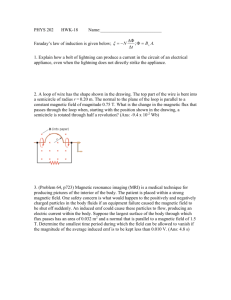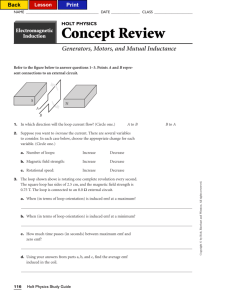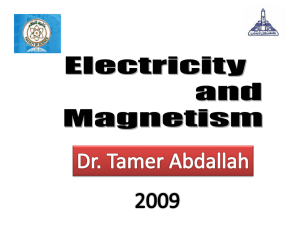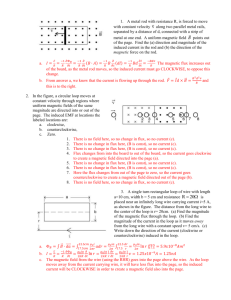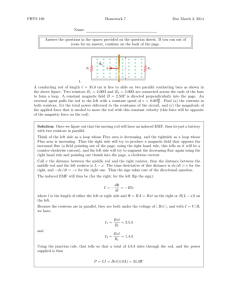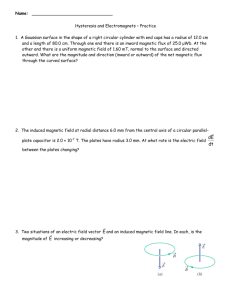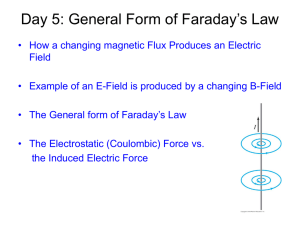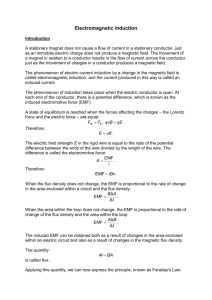Physics 111
advertisement
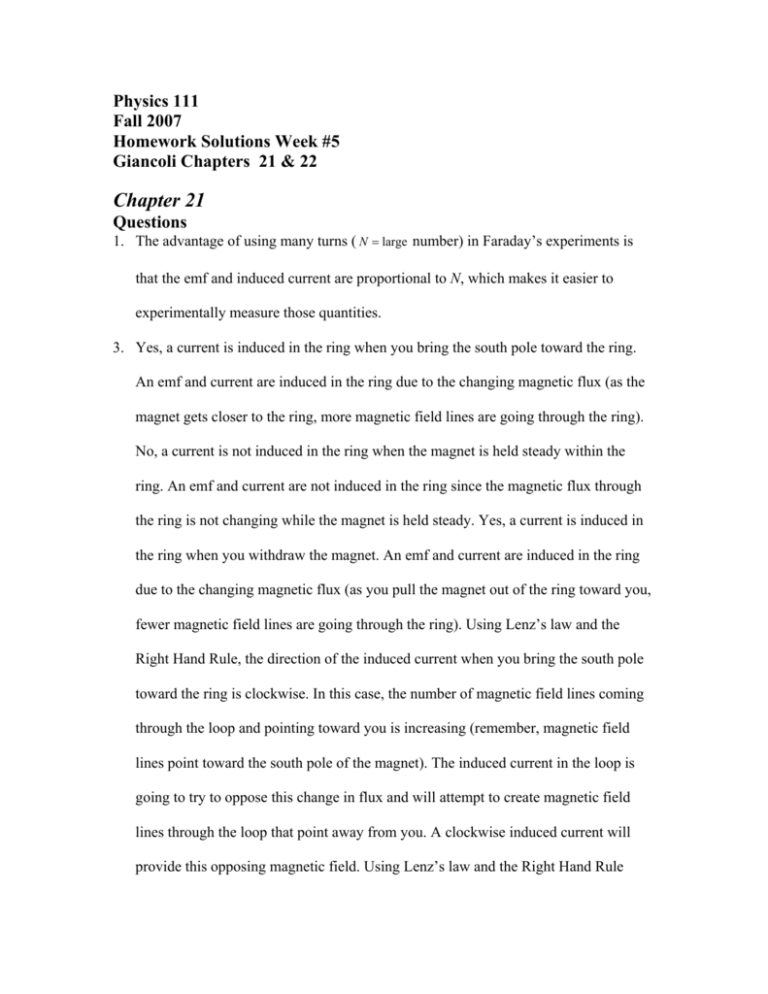
Physics 111 Fall 2007 Homework Solutions Week #5 Giancoli Chapters 21 & 22 Chapter 21 Questions 1. The advantage of using many turns ( N = large number) in Faraday’s experiments is that the emf and induced current are proportional to N, which makes it easier to experimentally measure those quantities. 3. Yes, a current is induced in the ring when you bring the south pole toward the ring. An emf and current are induced in the ring due to the changing magnetic flux (as the magnet gets closer to the ring, more magnetic field lines are going through the ring). No, a current is not induced in the ring when the magnet is held steady within the ring. An emf and current are not induced in the ring since the magnetic flux through the ring is not changing while the magnet is held steady. Yes, a current is induced in the ring when you withdraw the magnet. An emf and current are induced in the ring due to the changing magnetic flux (as you pull the magnet out of the ring toward you, fewer magnetic field lines are going through the ring). Using Lenz’s law and the Right Hand Rule, the direction of the induced current when you bring the south pole toward the ring is clockwise. In this case, the number of magnetic field lines coming through the loop and pointing toward you is increasing (remember, magnetic field lines point toward the south pole of the magnet). The induced current in the loop is going to try to oppose this change in flux and will attempt to create magnetic field lines through the loop that point away from you. A clockwise induced current will provide this opposing magnetic field. Using Lenz’s law and the Right Hand Rule again, the direction of the induced current when you withdraw the south pole from the ring is counterclockwise. In this case, the number of magnetic field lines coming through the loop and pointing toward you is decreasing. The induced current in the loop is going to try to oppose this change in flux and will attempt to create more magnetic field lines through the loop that point toward you. A counterclockwise induced current will provide this opposing magnetic field. 4. For the ring on the left side of the current-carrying wire there is no induced current. As the ring moves along parallel to the wire, the magnetic flux through the ring does not change, which means there is no induced emf and no induced current. For the ring on the right side of the current-carrying wire, the induced current is clockwise. As the ring moves away from the wire, the magnetic flux through the ring is decreasing (there are fewer magnetic field lines pointing into the loop). In an attempt to oppose this decrease (due to Lenz’s law), an emf and current will be induced in the ring in a clockwise direction (using the Right Hand Rule). Problems 2. As the coil is pushed into the field, the magnetic flux through the coil increases into the page. To oppose this increase, the flux produced by the induced current must be out of the page, so the induced current is counterclockwise. 5. The flux changes because the loop rotates. The angle changes from 0o to 90o. The magnitude of the average induced emf is given by Eq. 21-2a. π (0.060 m ) 1.5 T (cos 90º − cos 0º ) ∆Φ B AB∆ cos θ =− =− ∆t ∆t 0.20 s 2 π (0.060 m ) 1.5 T (0 − 1) =− = 8.5 × 10 −2 V 0.20 s 2 E=− 9. (a) The increasing current in the wire will cause an increasing field out of the page through the loop. To oppose this increase, the induced current in the loop will produce a flux into the page, so the direction of the induced current will be clockwise. (b) The decreasing current in the wire will cause a decreasing field out of the page through the loop. To oppose this decrease, the induced current in the loop will produce a flux out of the page, so the direction of the induced current will be counterclockwise. (c) The decreasing current in the wire will cause a decreasing field into the page through the loop. To oppose this decrease, the induced current in the loop will produce a flux into the page, so the direction of the induced current will be clockwise. (d) Because the current is constant, there will be no change in flux, so the induced current will be zero. 12. (a) Because the velocity is perpendicular to the magnetic field and the rod, we find the induced emf from Eq. 21-3. E = BLv = (0.800 T )(0.120 m )(0.150 m s ) = 1.44 × 10 −2 V (b) Because the upward flux is increasing, the induced flux will be into the page, so the induced current is clockwise. Thus the induced emf in the rod is down, which means that the electric field will be down. The electric field is the induced voltage per unit length. E= E 1.44 × 10 −2 V = = 0.120 V m , down 0.120 m l 15. As the loop is pulled from the field, the flux through the loop decreases, causing an induced EMF whose magnitude is given by Eq. 21-3, E = Blv. Because the inward flux is decreasing, the induced flux will be into the page, so the induced current is clockwise, given by I = E R . Because this current in the left-hand side of the loop is in a downward magnetic field, there will be a magnetic force to the left. To keep the rod moving, there must be an equal external force to the right, given by F = IlB . E Blv B 2 l 2 v (0.550 T ) (0.350 m ) (3.40 m s ) = = 0.548 N lB = lB = 0.230 Ω R R R 2 F = IlB = 2 Chapter 22 Questions 1. If the direction of travel for the EM wave is north and the electric field oscillates eastwest, then the magnetic field must oscillate up and down. For an EM wave, the direction of travel, the electric field, and the magnetic field must all be perpendicular to each other. 2. No, sound is not an electromagnetic wave. Sound is a mechanical (pressure) wave. The energy in the sound wave is actually oscillating the medium in which it travels (air, in this case). The energy in an EM wave is contained in the electric and magnetic fields and it does not need a medium in which to travel. 3. Yes, EM waves can travel through a perfect vacuum. The energy is carried in the oscillating electric and magnetic fields and no medium is required to travel. No, sound waves cannot travel through a perfect vacuum. A medium is needed to carry the energy of a mechanical wave such as sound and there is no medium in a perfect vacuum. 5. The wavelengths of radio and TV signals are much longer than visible light. Radio waves are on the order of 3 m to 30,000 m. TV waves are on the order of 0.3 m to 3 m. Visible waves are on the order of 10-7 m. 7. Wavelength of 103 km: Sub-radio waves (or very long radio waves; for example, ELF waves for submarine communication fall into this category). Wavelength of 1 km: Radio waves. Wavelength of 1 m: TV signals and microwaves. Wavelength of 1 cm: microwaves and satellite TV signals. Wavelength of 1 mm: microwaves and infrared waves. Wavelength of 1 µm: infrared waves. Problems 2. The current in the wires is the rate at which charge is accumulating on the plates and must also be the displacement current in the capacitor. Because the location is outside the capacitor, we can use the expression for the magnetic field of a long wire: ( 10 ⎛ µ ⎞ 2I B=⎜ 0⎟ = ⎝ 4π ⎠ R −7 )( −3 )= T • m A 2 35.0 ×10 A (0.100 m) 7.00 ×10 −8 T. After the capacitor is fully charged, all currents will be zero, so the magnetic field will be zero. 3. The electric field is ( )( −9 ) E = cB = 3.00 ×10 m s 17.5 ×10 T = 5.25 V m. 8 6. The wavelength of the radar signal is ( ( ) ) 3.000 × 10 m s c λ= = = 1.008 × 10 −2 m. 9 f 29.75 ×10 Hz 8 9. The time for light to travel from the Sun to the Earth is ( ( ) ) 1.50 ×10 m L ∆t = = = 5.00 × 102 s = 8.33 min. 8 c 3.00 × 10 m s 11
